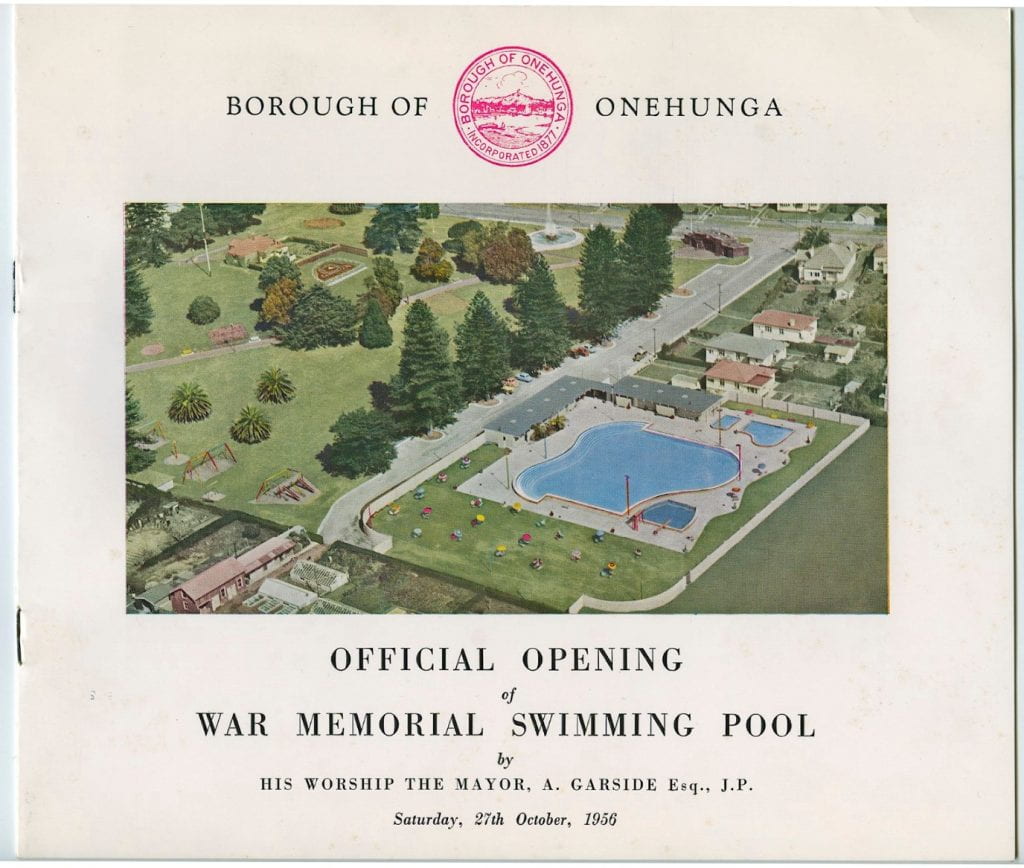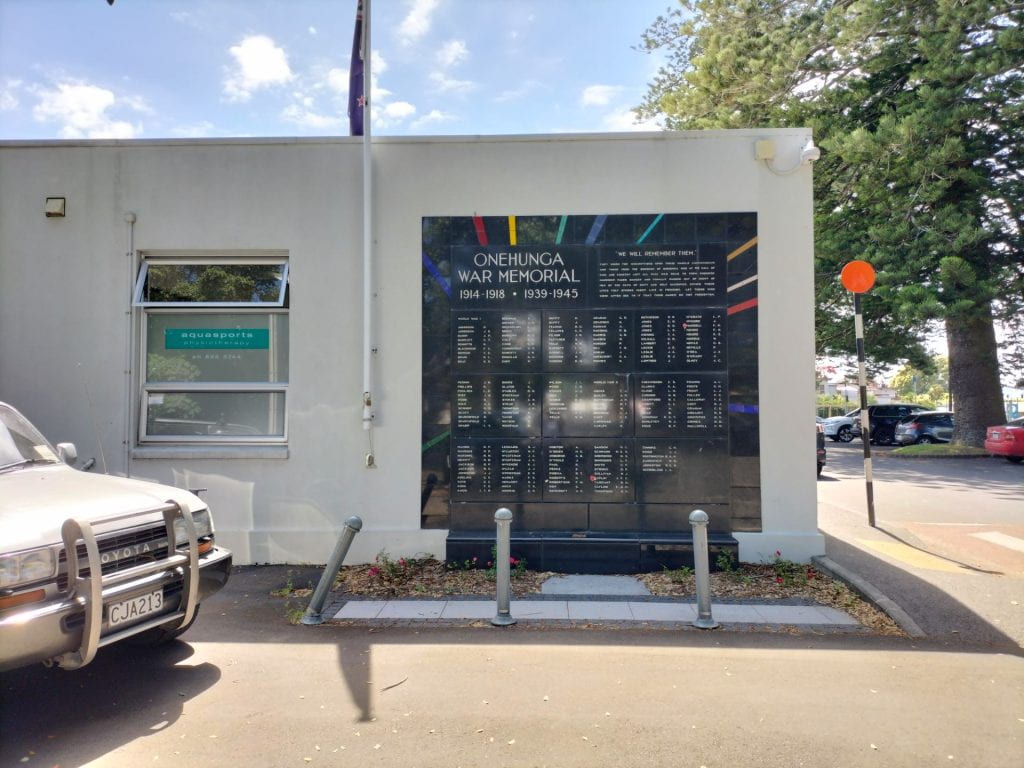Part One
Sacrifice, duty and blue space in Onehunga: exploring a mid-20th century memorial swimscape
Part Three
Jellicoe Park: a green space of remembrance
by Gretel Boswijk*
The outdoor swimming season has come to an end (except for those hardy folk who sea swim all year round) and ANZAC day 2022 has just passed by, with ceremonies held at war memorials around the country. What is the link between these two points? In the 20th century, and particularly after World War II (WWII), at least 16 swimming pools were constructed or vested with a memorial purpose often signified by entrance gates bearing a roll of honour or inscription. War memorials are a form of civic memory, created with the purpose of providing consolation to the living, honouring the dead, and reminding future generations of duty and sacrifice. Living memorials, such as swimming pools, combined memorialisation and remembrance with celebrating life, community, and the present; a dual role that can create tension between the sacred purpose of remembrance and the profane purpose of daily use.
Recently, I explored the origins, spatial layout and expression of memorial purpose at the Onehunga War Memorial Swimming Pool, Auckland (Figure 1), seeking to understand the persistence of memory in living memorials. This project emerged from occasional swims at the outdoor pool and taking time to look at the complex. I would wonder: Why a swimming pool as a war memorial? What makes it a memorial? Is this still a memorial? It was also stimulated by a comment in Historian Jock Phillips’ 2016 book on War Memorials that:
“Buildings such as community centres have become such a familiar part of our surroundings that, 70 years, after the war, it is easy to forget the reason for their existence. As the apostles of monumental memorials after the First World War had predicted, usefulness has indeed tended to obscure their existence.”

Figure 1: The outdoor swimming pool at the Onehunga War Memorial Swimming Pool and Leisure Centre, Onehunga, viewed from the high diving board on the east side of the complex. Norfolk Island Pines (Araucaria heterophylla) line the edge of Jellicoe Park to the south of the pool. Authors own, 2022
The lido-style swimming complex opened in 1956 (Figure 2) as a memorial those who served and died in World War I (WWI) and WWII, although it was not a fresh idea developed in the post-war period (see associated narratives). At the time it was constructed and opened, the swimming pool complex was described by the New Zealand Herald as ‘Aquatic luxury’ ‘[c]onsidered by overseas experts … to be the finest pool in Australia or New Zealand’. The free-form pool was reported as the largest of its type in Australia and New Zealand and the modern facilities and the planned gardens all demonstrated a new look complementing nearby Jellicoe Park.

Figure 2: Cover of the opening day brochure showing the new pool and part of Jellicoe Park with the WWI memorial, John Park memorial fountain, Blockhouse and floral clock. Image: Auckland City Archives OHB 050-6 brochure.
The complex was designed by architects Mark Brown and Fairhead and built by H.J. Short Ltd of Onehunga. The ethos of living memorials can be read in the form and style of the original buildings and the tanks, the materials used, and the organisation of space. The role of providing consolation and provoking remembrance were signified directly by the sacred space of the memorial dais and black granite wall at the entrance (Figure 3) and the glass case with the eternal flame and the book of honour in the ticket hall. These elements were integral to the design of the complex unlike stand-alone gates that were more common at other memorial pools.

Figure 3: The main entrance to the Onehunga War Memorial Swimming Baths, 1956. This image was reproduced in the Opening Day Brochure with the inscription “Remembering these dead, let the living be humble” below the image. Patrons would ascend the steps to enter the complex and remembrance would have been part of daily ritual. Auckland Libraries Heritage Collections 957-402.
Central to living memorials are the concepts of community, learning and the celebration of life, which are given material expression by the swimscape. The concrete block buildings were functional – providing changing rooms and administrative spaces – and an unobtrusive backdrop to the open expanse of the green lawn and swim space with its curves and colour. Tanks of different of sizes and depths catered for different ages, from toddlers to adults, and activities (playing, lane swimming, diving). The placement of a toddler change room next to the shallow pools supported parents (mothers) bringing young children to the pool for play or lessons. Spaces around the tanks and the wide lawn facilitated relaxing, socialising, and sunbathing.
Since the late 1980s, parts of the swimming pool complex have been changed and modernised transforming it from a seasonal to year-round leisure and fitness facility (Figure 4). An indoor pool was built on the lawn and the buildings have been altered and enlarged. The most important change was the relocation of the main entrance and the removal of the memorial dais when the space was enclosed to create a new room. At this time, the honour wall was relocated to the west wall, somewhat reduced in scale. The changes have kept the complex alive and relevant to the present, but have shifted the balance of purpose towards recreation. With the relocation of the honour wall, the memorial purpose of the complex has been externalised and diminished.

Figure 4: Comparison between the 1956 architects sketch from the opening day brochure and changes to the complex by 2017. Authors own, 2022
The opening day celebrations emphasized that it was envisaged as a “permanent symbol of commemoration and gratitude to those citizens of their Borough who made the Supreme Sacrifice in World Wars I and II”. To be ‘permanent’ implies something is unchanging and constant. The war memorial pool was invested with the notion that the structure would stand firm and carry its message into the future. But as novelist Ruth Ozecki reminds us, nothing is permanent: people die but grief does ease; things change and end; our needs shift and what was once valued or cherished can become irrelevant or discarded.
In the case of a living war memorial such as the Onehunga pool, as the time gap between the event and the present increases, its purpose of providing consolation to a community and individuals can fade or be superseded by other needs. The meanings embodied in these places that resonate with one generation can have less connection for the next who did not directly experience events or loss. For the generations who have grown up since, the pool may just be part of where they live. They may not know the history of the site or what the entire complex symbolises with the War Memorial perceived as being just the installation at the front of a building. And even this may not be respected as a sacred space. As a result, the present relationship of users to the space is different, as are their perceptions of that place. Without effort to maintain the fabric of such spaces and the stories associated with them, over time we will lose the memory of what these places meant as memorials.

Figure 5: The modern war memorial sits alongside an access drive and carparking, with a small garden protected by bollards. Authors own, 2022
